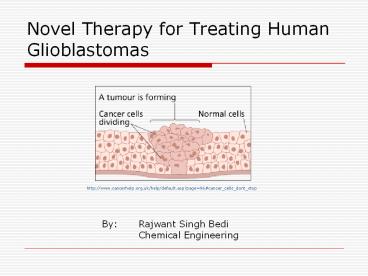Novel Therapy for Treating Human Glioblastomas - PowerPoint PPT Presentation
1 / 17
Title:
Novel Therapy for Treating Human Glioblastomas
Description:
Low pH is produced by lack of blood supply. ... to successfully inhibit 50% of sodium/hydrogen exchange in the tumor cell. ... – PowerPoint PPT presentation
Number of Views:76
Avg rating:3.0/5.0
Title: Novel Therapy for Treating Human Glioblastomas
1
Novel Therapy for Treating Human Glioblastomas
http//www.cancerhelp.org.uk/help/default.asp?page
96cancer_cells_dont_stop
By Rajwant Singh Bedi Chemical Engineering
2
Glioblastoma Mutiforme
- Most common type of malignant primary brain tumor
- Typically contain more than one type of cells.
- Characterized by rapid growth, these tumors can
grow quite large before clinically relevant
symptoms appear. - Symptoms include
- Motor weakness.
- Severe headaches, nausea, vomiting.
- Sometimes seizures.
http//www.emedicine.com/med/topic2692.htm
http//www.irsa.org/glioblastoma.html
3
Glioblastoma Mutiforme
- Normal cells survive at a pH7.4
- Glioblastomas can survive at pH6.9
- Low pH is produced by lack of blood supply. No
oxygen is received by cells for oxidative
phosphorylation, so cells use glycolysis, which
builds up protons inside the cells. - Glioblastomas use NHE1 to exchange H for Na
ions to increase pH inside the cell and maintain
homeostasis.
4
Previous attempts for a cure
- Radiation Therapy
- Slows down tumor proliferation, but does not cure
the tumor. - Can also damage normal tissue.
- Chemotherapy
- Highly toxic drugs are needed to cross the
blood-brain barrier. - These drugs may be toxic to other organs in the
body. So, combinations of drugs are used to find
the best drugs for the treatment. - Surgery
- Impossible to identify and remove all of tumor
tissue which extends into normal tissue.
5
Why new therapy is required?
- Poor clinical prognosis
- High recurrence rate
- Patients typically live only 6-12 months
following diagnosis regardless of therapeutic
regimen
6
Novel Therapy
- Amiloride derivatives
- Carefully designed to exploit metabolic
differences between normal and tumor cells - To produce cell death, drug must inhibit NHE1 and
NCX to cause intracellular acidosis and loss of
calcium regulation - Preferably only active in CNS or tumor
7
Testing efficacy of the drug
- Inhibition constant
- IC50concentration of drug where 50 Inhibition
of NHE1 occurs - Lower Inhibition constant is better as less
amount of drug is required to successfully
inhibit 50 of sodium/hydrogen exchange in the
tumor cell.
8
Methodology
- Determination of NHE1 IC50
- Cells grown in Petri dishes
- 37 degrees Celsius
- pH7.4
- Cells are subjected to the drug in vitro
- changes in pH are measured spectrofluorometrically
using a fluorescent dye, 2,7bis(carboxyethyl)-5
,6-carboxyfluorescin acetoxy-methyl ester (BCECF)
- Excitation wavelengths 507/440nm
- Emission wavelength 535 nm
9
Ammonium Prepulse Method
- Hepes Ringer
- Baseline measurement of pH
- NH4Cl
- Acidification of cell
- NMDG
- Sodium free solution which stops sodium/hydrogen
exchange - Add sodium to observe recovery /-Drug
- Drug inhibits NHE1, and thus recovery is slower
than just adding Na-containing Hepes ringer.
10
Graph produced by Data
Figure 1
11
Graphs continued
Figure 2
12
Graphs continued
Figure 3
13
Graphs continued
Figure 4
14
Data Analysis
Concentration (µM) NHE1i Slope Control Slope Ki
500 0.0005 0.0036 0.08
100 0.0015 0.0038 0.39
10 0.0028 0.003 0.93
y-intercept 1.3866
coefficient -0.2052
ln x (when y 0.5) 4.320662768
x (IC50) µM 75
NHE1i slope Determined from Figure 2 Control
Slope Determined from Figure 1 KiNHE1i
slope/ Control slope Y-intercept and
Coefficient Determined from Figure 4 IC50
Determined From equation Given by figure 4
15
Conclusion
- IC50 C2-Amiloride Glycine
- 75 uM
- Is lower than IC50 of Amiloride (124 uM)
- Lower IC50 means that a lower concentration of
drug is required to inhibit 50 of
sodium/hydrogen exchange in the tumor cell.
16
Further Experimentation
- In vivo experiments
- Track tumor progression in animal mode using
Proton Magnetic Resonance Spectroscopy (MRS)
imaging in the presence or absence of new drugs
17
Acknowledgements
- Fredric A. Gorin, Dept. of Neurology.
- Michael Nantz, Dept. of Chemistry.
- Hasan Palandoken, Dept. of Chemistry.
- Bill Harley, Dept. of Neurology.































